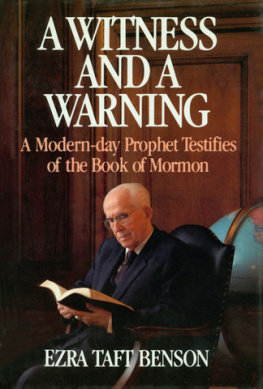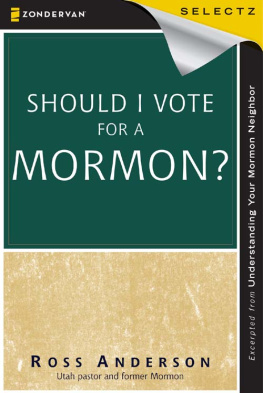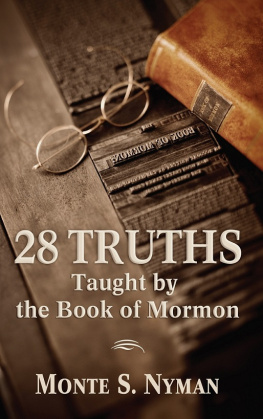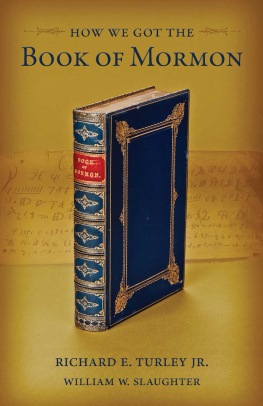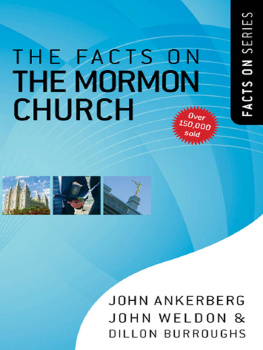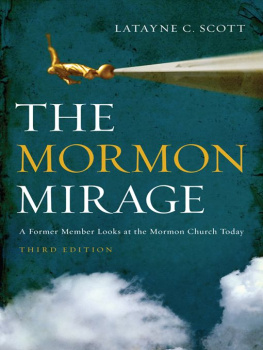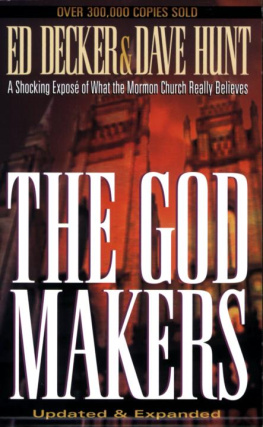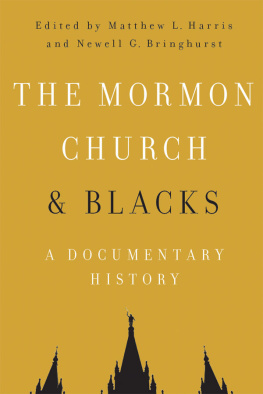Mormon Crisis: Anatomy of a Failing Religion
Copyright 2013 James A Beverley
All rights reserved
Printed in Canada
International Standard Book Number: 978-1-927355-32-9
ISBN 978-1-927355-33-6 EPUB
Published by:
Castle Quay Books
Pickering, Ontario, L1W 1A5
Tel: (416) 573-3249
E-mail:
www.castlequaybooks.com
Edited by Larry Matthews and Lori MacKay
Cover design by Burst Impressions
Printed at Essence Publishing, Belleville, Ontario
Scripture quotations marked NIV are taken from the HOLY BIBLE, NEW INTERNATIONAL VERSION . Copyright 1973, 1978, 1984 by International Bible Society. Used by permission of Zondervan Publishing House. All rights reserved. Scripture quotations marked KJV are from The Holy Bible, King James Version. Copyright 1977, 1984, Thomas Nelson Inc., Publishers. All rights reserved. Scripture quotations marked NKJV are taken from the New King James Version. Copyright 1979, 1980, 1982. Thomas Nelson Inc., Publishers.
This book or parts thereof may not be reproduced in any form without prior written permission of the publishers.
Library and Archives Canada Cataloguing in Publication
Beverley, James A.
The Mormon crisis: anatomy of a failing religion / James A. Beverley ; foreword by Sandra Tanner.
Includes bibliographical references.
Issued also in electronic format.
ISBN 978-1-927355-32-9
1. Mormon ChurchHistory. 2. Church of Jesus Christ of Latter-day SaintsDoctrines. I. Title.
BX8611.B49 2013 289.309 C2013-901387-3
Dedication
To my uncle Bill
(William Edward Bulman, 1920-)
Your dedication in fighting for freedom in World War II, your love for family and friends, and your faithful witness to Jesus Christ is an inspiration
Foreword
Sandra, thats blasphemy, replied the eighth grade Christian girl in response to my teenage attempt to explain LDS theology. The LDS quote I had repeated to her was the famous couplet by past LDS President Lorenzo Snow: As man now is, God once was; As God now is, man may be. It wasnt until several years later, after giving my life to Christ, that I realized the truth of my friends assessment.
There have been many changes in the Mormon world since that day in the 1950s, but much remains the same. Over the next 50 plus years my husband and I, both from fifth generation LDS families, published extensively on the historical and doctrinal changes of the LDS Church that led us to reject the religion of our childhood and embrace Christianity as revealed in the Bible.
In 1978 the LDS president announced a reversal of their ban on blacks holding their priesthood, yet their past racism continues to haunt them. And in recent years the LDS leaders have modified their teaching manuals to obscure their more heretical doctrines, such as God was once a mortal and achieved his present status of godhood after years of diligent effort. In 1971 their official church magazine, Ensign , published Joseph Smiths famous sermon on the nature of God. However, in recent years there have been only brief quotes from his sermon in their literature. For a while Lorenzo Snows couplet seemed to be pushed into the background, yet their 2013 priesthood manual, Teachings of Presidents of the Church: Lorenzo Snow , highlights his statement. In 1843 Joseph Smith introduced the secret LDS temple ritual, where couples are sealed in marriage for all eternity. But since 1900 the ritual has gone through various revisions. The history behind these events shows an ongoing effort to present the LDS claims in the most favorable light and to obscure the distinctions between biblical Christianity and LDS theology.
Professor Beverley and I first connected in 1978 when he began teaching on Mormonism. Over the years I have shared research material with him and helped him get connected to other Christian scholars of Mormonism, including Wes Walters and H. Michael Marquardt. As Mormonism extends its world-wide proselytizing efforts, with 55,000 young people serving two year missions, it is important that Christians understand and know how to respond to LDS claims. Professor Beverleys book is a welcome addition to the research on Mormonism. His book offers the reader an up-to-date, powerful and accurate critique of Mormonism.
Sandra Tanner
Co-founder Utah Lighthouse Ministry
Preface
Mitt Romneys run for President of the United States in 2012 was the main reason behind what was called the Mormon Moment. Could Romney, a Mormon, become the head of the most powerful nation on earth? In the end, Romney lost but the close election proved that his Mormon faith was not a barrier to millions of Americans. Overall, members of the Church of Jesus Christ of Latter-day Saints were proud of him and LDS leaders used the election as a context for renewed explanation and defense of the Mormon gospel.
The Mormon Moment has passed but there remains a need for careful analysis of the Latter-day Saints beliefs and practices. The intense focus on Mormonism through Romneys two campaigns for political leadership led to more heat than light. Much of the discussion on Mormonism lacked depth. Romney himself seldom got into details about his Mormon faith. As well, the LDS public relations machine often glossed over serious issues in Mormon history and belief.
The American evangelical Christian community was torn by how to react to Romney and Mormonism. Many evangelicals are Republican so wanted to vote for him but had serious concerns about Mormonism. This reached a telling moment when famed evangelist Billy Graham showed his support for Romney, followed by the removal of an entry on Mormonism as a cult from the website of the Billy Graham Evangelistic Association.
The win by Obama resulted in an instant quiet about Mormonism in the public square. However, the need for an up-to-date appraisal is urgent. First, contrary to popular impression, the LDS Church is in trouble in terms of growth and members leaving the Church. Second, the Mormon moment created uncertainty among evangelicals about the proper reaction to the LDS belief system. Is it Christian? Are Mormons spiritual brothers and sisters in Christ to Protestant, Catholic and Orthodox Christians? Is the Mormon Church becoming more evangelical, more attuned to the Bible and more Christ-centered?
The 2012 election season gave me the opportunity to return in a deeper way to my longtime study of Mormonism. I became interested in the LDS religion when I was studying at Trinity Evangelical Divinity School in 1976 in a class with Norman Geisler. I became a professor in 1978 and analysis of Mormonism became part of my regular teaching and has continued ever since. Different trips to Utah over the years have given me a chance to examine the LDS religion in its home base. One of those trips involved my coverage of Ravi Zacharias famous and controversial speech at the Mormon Tabernacle.
The LDS Church is in serious trouble. That explains my book title: Mormon Crisis and the subtitle: Anatomy of a Failing Religion. The troubles in the Mormon faith relate to two major realities. First, as chapter one notes, the Internet has created a huge problem for Mormonism because of the abundance of powerful and effective critique of the LDS religion. Second, and far more important, in spite of the phenomenal growth of the LDS Church in the twentieth century, huge defects in the Mormon belief system remain, as this book documents.
Anyone who studies the LDS Church cannot but help be impressed by many facets of the Mormon story and by many great elements in Mormon culture. Many ex-Mormons express their agony over leaving behind the wonderful support system that the Mormon community provides. The LDS Church offers a cohesive framework of faith set in the context of a powerful missionary force, a vast educational system, and worldwide relief network. The men who run the LDS empire have built up an astonishing array of temples, churches, educational institutes, and business interests. So, whatever concerns this book raises are set in the context of admiration for much about the LDS faith and especially deep appreciation for the many wonderful LDS people that I have met.


